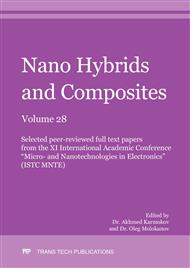p.26
p.31
p.39
p.48
p.53
p.59
p.65
p.71
p.78
Annealing Effect on the Composition and Electrophysical Properties of N-Type Silicon Surface
Abstract:
During low-temperature annealing, the segregation of the alloying element leads to a strong enrichment of the surface layer, causing a rearrangement of the surface electron structure. This change in the electron structure is manifested in the characteristic energy loss spectra. Annealing of single crystals at 400–500 K leads to an increase in the density of surface electron states. As shown by the calculations of the surface potential using experimental data on the temperature dependence of the surface concentration, dopant segregation causes a linear increase in the surface potential.
Info:
Periodical:
Pages:
53-58
Citation:
Online since:
February 2020
Authors:
Price:
Сopyright:
© 2020 Trans Tech Publications Ltd. All Rights Reserved
Share:
Citation:


